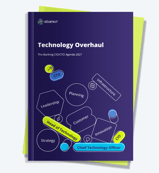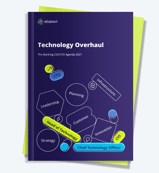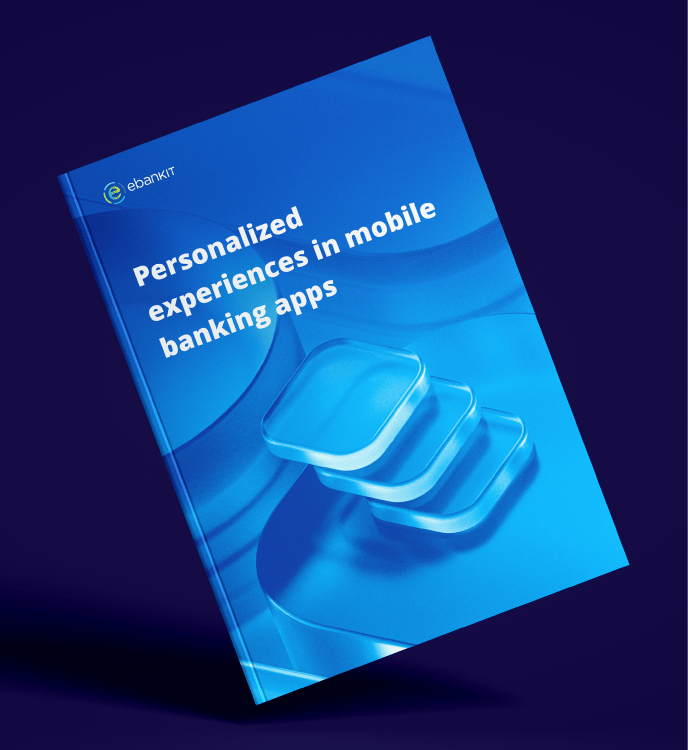Eradicating bad digital banking experiences
Recorded on June 11, 2025
![]()
![]()
![]()
SPEAKERS
SUMMARY
The session outlined ebankIT's product roadmap, focusing on short and long-term innovations, including modernized staff channels, cloud optimization, smarter customer engagement, and future-ready technologies like passwordless authentication and open telemetry—all aimed at enhancing efficiency, security, and user experience.
.
Key topics
A reimagined Branch Front Office and Contact Center with a unified, modern UI that aligns with self-service channels for improved customer insights.
The team showcased ebankIT's platform’s enhanced with loud capabilities, optimized for performance, scalability, and resilience.
Passwordless authentication (Passkeys, WebAuthn) and the shift to Open Telemetry for standardized, extensible monitoring and observability across the platform.
Transcript
00:00:00 - Introduction
In the first five minutes of the session "Eradicating Bad Digital Banking Experiences," Pedro Azevedo, Chief Product Officer at ebankIT, opens the talk by introducing his colleagues Paula Oliveira (Head of Digital Experience) and Luís Allen (Product Analyst). He sets the stage for a varied agenda, starting with a reflection on the 2023 Backet Summit and then transitioning to broader topics that go beyond technical development—focusing on what it truly means to excel in digital banking.
Pedro emphasizes that while AI will be discussed later, the initial roadmap presentation is more human-centered. Before diving in, he reflects on the purpose behind roadmaps and uses a bold quote from Demis Hassabis (CEO of Google DeepMind and Nobel Prize winner) to illustrate this: the idea that AI could one day cure all diseases. Pedro questions why such a powerful statement received so little mainstream attention or stock market impact, suggesting that despite its significance, the world may be more captivated by flashy AI demos than long-term transformative visions. This introduces the theme of aligning roadmaps with meaningful, visionary goals.
00:05:00 - Balancing ambition with realism in digital banking
Pedro Azevedo continues his reflection on ambitious goals and the importance of grounded, clear roadmaps. He questions the realism of bold claims like "curing all disease with AI," highlighting how even AI chatbots estimate the likelihood at under 2%. Despite his respect for Demis Hassabis, Pedro suggests such grand goals can feel disconnected from reality—especially when companies like Google still appear more focused on ad revenue.
He then transitions to how these ideas relate to ebankIT's own purpose. Unlike curing all disease, ebankIT focuses on eradicating bad digital banking experiences—a mission that is both ambitious and realistic within their domain of expertise. Pedro stresses that they truly understand the challenges in digital banking and believe they have effective solutions.
He explains that “bad” experiences don’t just mean errors or bugs; often, they’re simply uninspired, unremarkable experiences that could be much better. The goal is to make these experiences exceptional through customization, configurability, and constant improvement of the platform.
Finally, Pedro emphasizes the importance of not stagnating—they're committed to continual progress, with no version being the final one. He concludes this segment by preparing to assess how well they’ve actually delivered on past roadmaps, hinting at an honest evaluation of what was promised versus what was achieved.
00:10:00 - Delivering on promises from ebankIT 2023
Pedro Azevedo revisits the 2023 ebankIT Summit roadmap to evaluate what was delivered. He confirms the successful rollout of key features, including: ultra-personalized campaigns, security settings overview panel, enhanced mobile app extensibility via ebankIT Studio X, New AI assistants integrated into the platform, A customizable dashboard for end users.
He stresses this is not to boast, but to highlight that while they delivered many planned items, some were adjusted or replaced—acknowledging the need for flexibility in any roadmap.
The focus then shifts to the customizable dashboard, shown in a demo video. Users can now personalize their landing page widgets, reorder or remove elements, activate new widgets tailored to their interests, use different configurations for personal and business profiles, and access segmented widgets for commercial banking (e.g., pending approvals, large contract views).
Additionally, Pedro showcases new widgets like multi-product carousel, colorful savings and credit card visualizations, stock market integrations (ticker, heatmap, top stories).
The key message was that ebankIT is enabling deep personalization and modularity, making digital banking more human, relevant, and adaptable.
00:15:00 - Low code AI development
Pedro transitions from personalization into how AI and developer experience are shaping the platform’s evolution—particularly through low-code extensibility. ebankIT is built for extensibility via its ebankIT Studio, with many features out of the box but designed to be customized. The team is embracing AI carefully—not for full code generation (to avoid reliability and security risks), but for AI-assisted development.
Pedro stresses the importance of treating code as a liability (needs maintenance, has risks), and valuing the knowledge behind the code as the true asset.
He then hands over the presentation to Luis, who presents a demo of a new AI-powered Studio X feature. It's a tool called “wireframe to transaction wizard” that allows developers to upload a hand-drawn image (like a form sketch). AI reads and extracts UI components and labels. Components are auto-generated into a front end. Developers can review, edit, or add any missing labels. They can also quickly compile and test the output in the browser.
Luis emphasizes the efficiency boost this brings without losing developer control—AI only generates what it's confident in, and everything remains editable.
00:20:00 - Bill payments experience for Canadian Credit Unions
This segment focuses on the Canadian layer of the ebankIT platform, with a detailed walkthrough of the redesigned Bill Payments feature, tailored specifically for Canadian credit unions based on user feedback.
The Bill Payments UI was completely redesigned to reflect actual user behavior and suggestions from Canadian credit unions. Two separate UX flows were created:
- Internet Banking: optimized for multiple payments and a more detailed, organized experience.
- Mobile Banking: streamlined for quick, single payments on-the-go.
The speaker gives a walkthrough of the internet banking interface. The user has to log in and go to “Pay Bills.” Then, they can manage payees: add, edit nicknames, reorder, and toggle visibility. They can also fill out payment forms or use pre-saved operations. They can schedule future payments. A final confirmation screen shows the total and details for each transaction.
For mobile banking, the process is equally streamlined. Users first select a source account, then access a quick payment form with just the essential fields—payee and amount—and optional fields for description or scheduling. The interface is designed for speed, featuring a prominent “Continue” button to prioritize fast payments, and the option to add another payment before completing the submission.
The speaker shows a strong example of localized customization, showing how the platform adapts to user expectations and context-specific needs while maintaining consistency across channels.
00:25:00 - Particle Design System
This segment transitions from localized features for Canada into platform-wide product improvements, emphasizing documentation, design systems, and accessibility, all as part of ebankIT's evolving strategy.
Beyond bill payments, the platform delivers a full suite of features tailored to the Canadian market. Users benefit from remote check deposit via web—ideal for tablet use—secure CRA (Canada Revenue Agency) payments, and business-oriented tools such as Interac transfers and automated funds transfers. Additional capabilities include viewing, copying, or sharing void cheques and seamless access to all digital documents.
Following this, the presentation transitioned to a behind-the-scenes look at the infrastructure that supports ebankIT’s delivery of features and updates.
The team highlighted the importance of not only writing good code but also supporting it with clear, accessible communication. As part of this commitment, ebankIT is preparing to launch a completely redesigned documentation website, marking a move away from traditional PDF-based manuals.
This new platform will make information more accessible and easier to navigate, with content organized by product area and release version. Instead of long, dense documents, users will find shorter, more digestible pages, enriched with relevant code snippets and enhanced search functionality. The documentation will cater to a range of user profiles, from developers to project managers, and will be launched by the end of the year, accompanying the next NXP release.
Another significant advancement discussed was the introduction of the Particle Design System, which was formally launched in 2024. This system represents a major investment in improving user experience across all self-service applications, spanning internet banking and mobile apps.
It consists of three design systems, each customized for a specific platform: web, iOS, and Android. The foundation of this system is built on customizable design tokens that control core elements like color palettes, typography, and spacing. With these tokens in place, a component library has been developed, offering pre-defined elements with documentation detailing how they should be used, including accessibility considerations.
The practical implications of the Particles Design System were demonstrated with a before-and-after comparison. The same application could be transformed from a default “vanilla” layout into a fully branded and visually distinct version simply by tweaking foundational elements and components. This approach allows for both rapid development and deep customization.
In upcoming releases, ebankIT plans to extend the design system to support larger screen widths and more responsive breakpoints. These changes will allow content to be rearranged more efficiently, reduce vertical scrolling, and open up new user experience possibilities by consolidating widgets and displaying more information at once.
Accessibility was another key theme. Rather than treating it as a checkbox for legal compliance or corporate image, ebankIT presented it as a core value—an opportunity to remove barriers and make digital banking inclusive for as many users as possible.
The Particles Design System has been built with accessibility guidelines in mind from the start, and the company is now collaborating with external consultants to ensure conformance with global accessibility standards and to continue improving their platforms accordingly.
The section concluded with Pedro rejoining the stage to guide the audience into the final part of the presentation: a forward-looking view of ebankIT’s roadmap and what’s next for the platform’s evolution.
00:35:00 - ebankIT's Roadmap
The presentation turned toward outlining the roadmap that will guide ebankIT’s future development. Pedro began by emphasizing the importance of balance in defining the product roadmap—a concept he referred to as the “product roadmap equilibrium.”
This balance is necessary because a roadmap carries with it certain expectations and risks. While stakeholders expect constant innovation, there's also a demand for stability and reliability; moving fast and breaking things is only appealing until something important actually breaks.
Additionally, although the industry is saturated with emerging trends and "fear of missing out" is common, constant shifts in direction can create instability. Instead, customers value clarity and consistency in technological evolution.
Pedro also highlighted the tension between being disruptive—delivering new, unique value—and maintaining continuity so that current customers are not left behind.
Disruption is necessary for differentiation, but it must come with upgrade paths and migration support to avoid alienating existing users. Furthermore, while each client may have unique feature requests, trying to satisfy everyone equally can lead to an overly complex, bloated product, ultimately reducing efficiency.
To manage these competing demands, ebankIT’s strategy is grounded in a framework that emphasizes practical, incremental innovation. Rather than building flashy solutions in search of a problem, the team seeks to identify real user needs and solve them effectively.
Their approach to trends includes maturity checks to avoid chasing every fad. When disruptive change is introduced, tools like ebankIT Studio and migration assistants are built into the development process to help existing users make the transition smoothly.
Saying "no" when necessary is also part of maintaining focus and efficiency, and the platform's configurability and extensibility allow clients to tailor it to their own needs when something custom is required.
Pedro then transitioned to how this roadmap thinking is already being applied to product development. Since the last summit, the team has been busy reimagining and migrating features from the existing platform to the new NXP architecture.
One of the new features on the horizon is the KYC (Know Your Customer) prompt. This feature is designed to help users keep their personal data up to date by prompting them—at login or another configurable moment—to refresh their information. The prompt is customizable, integrates with core banking systems, and helps institutions stay in compliance with regulatory requirements.
00:40:00 - New features
A new financial overview widget was introduced, which provides users with a clear snapshot of their assets and liabilities. This widget aims to simplify financial visibility, especially for users managing multiple products. Though it had been shown earlier, its importance was reiterated as a useful dashboard element that helps users stay informed about their overall financial position.
Another key feature discussed was bulk transaction upload, which is particularly valuable for commercial and small business users. Instead of entering transactions manually—such as payroll or supplier payments—business users can now upload a single file containing all the necessary operations.
The system then processes these in bulk, even if the client’s core banking solution lacks native support for such functionality. This enhancement significantly reduces the administrative burden of repetitive monthly tasks.
The user engagement hub has also been revamped. This tool now allows institutions to collect private, contextual feedback from users directly within the app—rather than relying on public app store reviews. This internal feedback mechanism enables banks to capture more actionable insights, as they can correlate responses with specific users, devices, and in-app behaviors. It’s a more controlled and informative way to understand user experience and identify issues.
Following this, Luis introduced redesigns aimed at making banking more accessible and discreet in everyday scenarios. For instance, the system widgets and smartwatch app now offer users at-a-glance access to account information without needing to open the full banking app. These widgets can show balances or recent transactions and come in multiple sizes and styles to match user preferences. On a smartwatch, users can view balances, transaction history, and notifications—ideal for quick checks in public situations like waiting in line at a store.
Luis also demonstrated how these tools are designed for real-life convenience, such as using favorite transactions for rapid money transfers, or discreetly checking your balance on your watch while out jogging. The goal is to increase banking accessibility in a way that is seamless and respectful of the user's context.
Pedro then returned to close the session and introduce longer-term initiatives under development, most of which are targeted for release in the following year. The first major topic was passwordless authentication, an increasingly popular technology being adopted by tech giants like Apple, Google, and Microsoft through passkeys and WebAuthn. Although digital banking often takes a conservative approach to authentication due to high security demands, ebankIT believes this trend will become standard and is exploring ways to implement secure, password-free login methods based on PKI (Public Key Infrastructure).
Finally, Pedro mentioned the shift toward OpenTelemetry to replace the current monitoring tools. This move will allow developers and administrators to use standardized, possibly open-source, tools to gain more detailed and customizable insights into platform performance and activity—ultimately improving visibility and control over the system’s inner workings.
00:45:00 - Cloud optimization
The speaker wrapped up by highlighting two major long-term initiatives: cloud optimization and the reimagining of staff channels, specifically the Branch Front Office (BFO) and Contact Center.
The cloud optimization initiative aims to take the platform's efficiency, scalability, and resilience to a new level. While details were limited, it was emphasized that the company has now reached a maturity point in its cloud infrastructure that allows for deeper optimization—ensuring smoother, more robust performance across deployments.
The main focus, however, was on the modernization of staff channels. Both BFO and the Contact Center are being redesigned with a standardized, modern user interface that aligns visually and functionally with self-service channels. This alignment is part of a broader move toward a consistent omnichannel experience, giving staff deeper insights into customer profiles and interactions. The redesigned interface is also being integrated with existing AI and data analytics initiatives within financial institutions, aiming to make human-assisted channels more intelligent and effective.
A prototype of the new BFO interface was shown. Key features included a smart search bar for quick customer lookup using multiple identifiers (name, phone, taxpayer number), recent customer history, contextual information such as recent processes, and quick actions. In the example of customer Claire Olive, the interface displayed her account details, ongoing interactions, financial activity, contact history, and even personalized campaign suggestions like a next-best offer for a term deposit.
The prototype also demonstrated a more three-dimensional customer view, accessed via swipeable panels. These included security status, showing login attempts, password changes, and device health; aconnection network, mapping the customer’s relationships across personal and business profiles; and sentiment analysis, using data like message content, engagement feedback, error frequency, and device optimization to gauge the customer’s overall satisfaction and experience.
The session concluded with a teaser for upcoming topics, including a dedicated session on security, a commercial user-focused presentation, and an in-depth look at artificial intelligence later in the day. The speaker thanked the audience and co-presenters, expressing enthusiasm for what’s still to come.




%20without%20SAM%20-%20Maturity%20Level%20-%202-KO%20edit.webp?width=160&height=57&name=67768-ebankIT%20Platform%20-%20CMMI%20Development%20V2.0%20(CMMI-DEV)%20without%20SAM%20-%20Maturity%20Level%20-%202-KO%20edit.webp)
